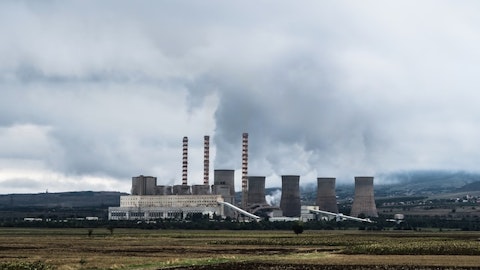Operator: Our next question will come from Tate Sullivan with Maxim Group. Your line is open.
Tate Sullivan: Can you go into some more detail on that $80 million liquefied natural gas keeping storage facility? Jeff, how long was that under planned? And are there riders associated with that or most of the gross margin will come after construction is finished in 2025? Is that the case?
Jeff Householder: Yes. The margin really is targeted at that in service date period. We’ve been looking at our growth on the Delmarva Peninsula. Frankly, there was some amazement for the last decade. As we’ve indicated a number of times before we’re seeing growth rates customer growth rates in evolution systems that exceed 5% per year, and we have been planning our gas supply activities accordingly. And so if you project out the next few years of growth that continues at those levels and even in an environment where the mortgage rates have increased significantly, we’re still seeing substantial customer growth there projected by the dealers on that Peninsula for a number of years to come. And so, we started looking at, our peak delivery capabilities over time and our modeling would indicate that at some point in future we need to do something, either add additional upstream pipeline capacity or find market area supply capabilities.
And the LNG project turned into frankly the most economic for rate payers option that we have available, and it provides that sort of winter time peak demand, peaking service that will allow us to continue to expand our distribution delivery services for a number of years to come? It will fix everything forever, but it’s a nice addition to the other peaking service capabilities that we have on the Peninsula. We don’t have a base load capacity issue there. This is primarily intended to deal with those significant weather related winter peaks.
Tate Sullivan: And then, is it based on the winter peaks? There’s no need for an LNG duplication facility in Florida? Is that the case?
Jeff Householder: No, we actually have a significant amount of pipeline capacity for our legacy system for the public utilities. We could always use more. I mean there are constraints on the pipeline systems in Florida, especially going into South Florida. And in fact, as you may know, the Florida City Gas folks have activated an LNG storage facility down in Miami, South of Miami actually, to provide peaking services for that system. So, we will inherit an LNG peaking storage facility in Miami, and we’ll build one in Maryland that will provide is to the customers of the Delmarva Peninsula. So, there are issues there, and I’ll just add to that. One of the things that’s intriguing about the Florida City Gas opportunity is the pipeline transmission investment opportunity to add to the interstate capacity going into South Florida.
And so, we think there are significant opportunities to help increase the capacity the levels into our Palm Beach service territory on FPU and then further south into Florida City Gas’ Miami service areas.
Operator: [Operator Instructions] And our next question comes from Brian Russo with Sidoti. Your line is open.
Brian Russo: I’m just curious, when we look to the fourth quarter of 2023, clearly, you demonstrated very strong third quarter margin and earnings growth. Is there any reason not to expect that type of trend in the fourth quarter of 2023? Are there costs that you help to mitigate weather earlier in the year, that will kind of reverse in the fourth quarter? Or just any insight there would be helpful?
Beth Cooper: I think, Brian, some of what you saw both in terms of the margin expansion within the quarter, as well as, we did have some cost increases in areas like facilities and maintenance and also on the employee side as well, and my expectation is you would expect those costs to continue to increase as we’re coming into the fourth quarter. And what I would say is, at the same, we are managing our cost very tightly as Jeff and I both have talked about, so both of those would be a factor. One of the biggest drivers on the margin side also, as you know, is the impact of our natural gas rate case. And so, you’ll have another piece of that that will hit in the fourth quarter. We’ve kind of put some estimates in our gross margin table.



